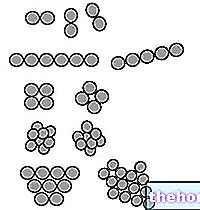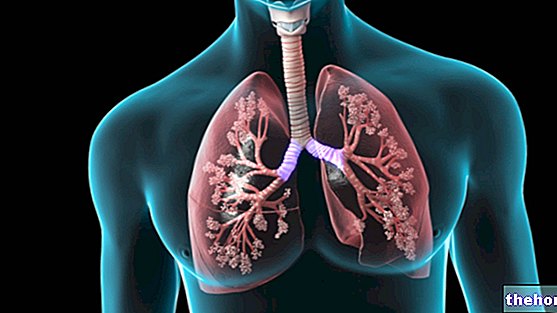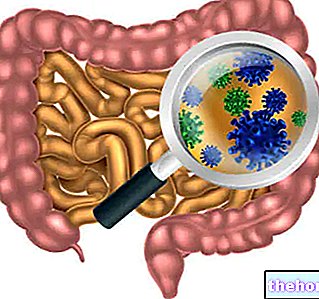See also: bacterial poisoning
What is a Bacterial Toxin?
Bacterial toxins, harmful molecules produced by bacteria, are divided into two large groups, that of ENDOTOXINS and that of EXOTOXINS.
- Endotoxins are structural components of the bacterium, typical and exclusive of GRAM negative bacteria; they are made up of lipid A (the inner layer of the LPS liposaccharide, which in turn constitutes the outermost portion of the membrane that lines the cell wall). They are released when the bacterium dies and in this respect are more dangerous than exotoxins.
- Exotoxins are not structural components, but simply substances released externally by the bacterium; they are produced by both GRAM + and GRAM -, but are typical and exclusive of each bacterium (as opposed to endotoxins). Consequently, each exotoxin it is responsible for a different symptomatic effect and supports the specificity of the morbid picture.
Denaturable, if treated with substances
suitable chemicals, such as acids
They stimulate our body to produce
specific antibodies (they are excellent antigens)
ANATOXINS are exotoxins that have lost their toxicity, but have retained their antigen characteristics; consequently, these substances are able to stimulate the production of antibodies without causing harm to the organism (some vaccines).
Exotoxins
They are expelled from the outside by the bacterium and can spread in the host; for example, the Clostridium tetani it remains confined to the site of infection and from there releases toxins that reach the central nervous system through the bloodstream.
Exotoxins can be monomeric, dimeric or multimeric; most are of the dimeric type and as such consist of a peptide A, which is the toxic part, and a peptide B, which acts as a receptor for the target cell. These two subunits are linked by a sulfide bridge, which breaks as soon as subunit B binds to the cell receptor, thus allowing subunit A to enter the cell.
On the basis of the mechanism of action, specific for certain organs or body structures, we distinguish cytolytic, ciliostatic, neurotropic, enterotoxic, pantropic and superantigens exotoxins.
CITOLYTIC EXOTOXINS: or haemolysins; they form channels in the plasma membrane, through which the cell loses water and salts, until it dies by osmotic lysis. An example is staphylococcus aureus, responsible for skin diseases (acne, boils, etc.) and food poisoning; it produces various toxins, including one called alpha with cytolytic activity.
CILIOSTATIC EXOTOXINS: act on the ciliated epithelia of the mucous membranes, blocking their movement and facilitating bacterial colonization; typical is the pertussis toxin.
NEUROTROPIC EXOTOXINS: typical examples are given by botulinum and tetanus toxin; the first acts on the peripheral nervous system, at the level of the neuromuscular junction, inhibiting the release of acetylcholine with consequent death from flaccid paralysis (one gram is enough to kill 10 million people, see also botulinum). The tetanus exotoxin, on the other hand, acts on the central nervous system, at the level of the synapses, where it blocks the release of neurotransmitters that inhibit the nervous impulse; consequently, the host dies from spastic paralysis.
Enterotoxic or enteropathogenic exotoxins: typically cause vomiting and diarrhea. A typical example is the "exotoxin of cholera, which acts mainly in the small intestine, activating an enzyme called adenylate cyclase and leading to an overproduction and accumulation of cyclic AMP. Consequently, the water and electrolytic exchanges of the cell are altered. cell, until the death of the individual from severe dehydration.
PANTROPE EXOTOXINS: inhibit protein synthesis; diphtheria toxin is an example.
SUPERANTIGENS: they upset the protective mechanism of the immune system, generating an exaggerated inflammatory response, with overproduction of pro-inflammatory cytokines and the onset of fever, protein hypercatabolism, up to hemodynamic shock.
Endotoxins
They consist of lipid A, which when released in large quantities after the death of the bacteria, produces a series of negative symptoms, first of all the rise in temperature (it is said that endotoxins possess a "high pyrogenicity). These symptoms are mediated by the release of substances with powerful inflammatory action (such as certain prostaglandins and interleukin-1). Then there is an "activation of the mechanisms that lead to blood coagulation and peripheral vasodilation, with an increase in capillary permeability (formation of edema and possible hypodynamic shock in people already suffering from low blood pressure). Despite this, it is believed that small doses of endotoxins carry out activities that are partially or entirely beneficial for the host, since they positively stimulate the functionality of the immune system. In fact, the GRAM bacteria - present in our intestine continually release small amounts of endottosins.
Endotoxins are extremely resistant to heat and physical agents; therefore environmental contaminants are frequent.
Other articles on "Bacterial Toxins"
- bacteria accessory structures
- bacteria
- characteristic bacteria
- bacterial cell
- Bacteria: transfer of genetic information
- Bacteria: transfer of genetic information
- Antibiotics
- Categories of antibiotics
- Antibiotic resistance




























